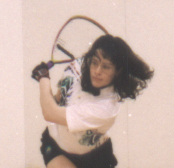|
|

Customizing Your Racquet
By Steve Crandall
Vice President, Sales & Marketing
Ashaway Racket Strings
We've discussed at length how to "tune" your racquet through your choice of string type and tension. Let's now look at some other accessories to customize your racquet. I got help from Jonah Bishop, owner of Racquet Sports Unlimited (Pittsburg, KS, ph: (316) 231 - 3530); and Rex Lawler, owner of Lawler Court Products (Terra Haute, IN, ph: (812) 235 - 3701). Both are good friends, tournament players, and experienced stringers, and even though they often disagree, I'd trust either of them for good advice.
 According to Jonah, vibration dampeners cut the amount of high-frequency vibration that is transferred from the strings, through the frame, and into your arm. This vibration, he explains, can aggravate an existing arm injury, although it's unlikely to cause injury by itself. "Dampeners work," he says, adding that they weigh very little, and their effect on racquet balance is negligible. According to Jonah, vibration dampeners cut the amount of high-frequency vibration that is transferred from the strings, through the frame, and into your arm. This vibration, he explains, can aggravate an existing arm injury, although it's unlikely to cause injury by itself. "Dampeners work," he says, adding that they weigh very little, and their effect on racquet balance is negligible.
Dampeners come in two basic types: a plastic button that snaps over the strings, and a thick ribbon of fabric, rubber, gel, or some combination thereof, which is woven through the strings. Both are installed at the racquet's throat, just above the handle. (Some players weave a regular rubber band through the strings.)
"Dampeners don't interfere with shot making," says Jonah. "If you were to hit the ball down there in the throat, you'd have blown it anyway." He notes, however, that dampeners deaden the feel of the racquet, which can rob the player of valuable tactile feedback, because mis-hits and good shots feel much the same.
Rex, on the other hand, says the benefits of dampeners are mostly psychological. "Very little vibration goes down the string toward the throat area where the dampener is," he says. "It radiates out at all angles into the frame, then down the frame into the handle, and then into your arm if there's enough of it." Rex says dampeners do change the sound of the racquet, and that many players equate this to a reduction in harmful vibration.
But Rex sees no disadvantage to dampeners, and agrees that they do reduce at least some vibration. Considering that they last almost forever, and cost just $3 or $4, I'd say there's really no reason not to try one and form your own opinion.
Adhesive-backed lead tape can be used to customize the weight and balance of a racquet, and even slightly shift sweet spot location and shape. But, according to Jonah, re weighting a racquet is a job only for experienced technicians. "Even most stringers are not qualified to weight and balance a racquet," he said. "I hesitate to give players general advice on the subject, because it's too easily misinterpreted. A lot of the changes that players seek might better be made by modifying their grip, or their stance, or their swing, than by re-weighting the racquet."
Rex has no such compunctions. He recommends the use of Gamma Swing Weights™ to some players, and encourages them to experiment with the number and placement until they get the feel they like. Swing Weights. are discrete, adhesive-backed, 3 gm. weights that are applied to the inside surface of the frame, between the strings, as compared to tape, which is cut to length and applied on the outer surface. Tape must be removed for every string job, while Swing Weights. can remain in place through re stringing.
Other accessories? There's your choice of grips. Rubber, slip-on grips are a bit heavier than most wrap-on grips, but tend to last longer, and most players find them easier to keep hold of, especially if they're wearing gloves. On the other hand, wrap-on grips are available in a wider variety of materials, textures, thicknesses, etc. The choice is strictly a matter of preference.
Wrist lacers replace the regular safety cord that comes attached to the butt of the handle. Rex feels that lacers are a little more convenient, because they stay snugged up and don't get in the way if you have to shift your grip during a rally.
Stringers often stencil the logo of the racquet manufacturer, or perhaps the Ashaway String logo, onto the stringbed. I'm not sure that ink is an "accessory," but the logos do look cool. We've found that a felt-tip pen produces a neater job than regular stencil ink, and the logo seems to hold up longer as well. Players have asked if the ink might react with the string in any way. The answer is: No. So stencil away to your heart's content.
This article previously appeared in Racquetball Magazine.
|